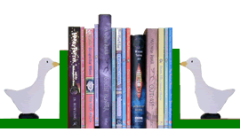Do you want to write a picture book? Are you tempted by only having to produce a few hundred words instead of the thousands required for a full-length novel? Well, don’t be fooled. Successful picture book writing is far more difficult than it looks.
A successful story for children needs the same essential components as one for adults – a main character with whom readers (or, in this case, listeners) can identify, a plot which faces that character with a situation he or she will have to struggle to resolve and an ending which brings the story to a totally satisfactory conclusion. It’s the difficulties the character faces and the ways in which he tries to overcome them which give the book its page turning quality while it’s the satisfying ending which produces those cries of read it again which are the sign of a good picture book.
The skill of the picture book writer is to compress all these components of a story into just a few hundred words. For a picture book is not really a short story for children. It’s a long story told short.
Of course, the problems and difficulties need to be ones which young children can understand. Whereas the main character in an adult novel may be struggling to save the world, picture book characters are more likely to be trying to overcome their fear of the dark, searching for a lost toy or adjusting to the arrival of a new baby.
The characters also need to be ones with whom young children can readily identify. Other children work well and so do young animals (especially bears) but tales about Timmy the Toothbrush and other inanimate objects are less successful. Nick Butterworth’s Percy the Park Keeper is a rare adult main character in a picture book but he is noticeably short and childlike in shape.
Once you have developed your story in your head and start to write it down, remember that picture books are written in a slightly different style from books intended for older children. This is partly because of the age of the intended audience but mainly because they are designed to be read aloud. You need to keep your sentences short and straightforward so they are easy to understand. It’s also important to repeat your characters names frequently because too much use of he or she can confuse young listeners.
Repititions of words and phrases plays an important part in picture book stories. It can help give a rhythm to a story and small children love to join in with the parts they know. I expect you remember chanting I’ll huff and I’ll puff and I’ll blow your house down with the big, bad wolf or growling Who’s been sitting in my chair? with the three bears. Both these stories also illustrate the way the number three can add rhythm to a picture book. Repeating something three times, grouping adjectives in threes and letting the character fail twice but succeed the third time all give a satisfactory feel to a story.
Of course, the words are only part of a picture book. The illustrations are a vital part of the story telling process, helping the story come alive and adding details which the text doesn’t provide. As you write, imagine the pictures which could accompany it and don’t waste words on information they can convey. Make sure you include plenty of action in a variety of settings to provide scope for the artist. Pages and pages of almost identical pictures of people talking are unlikely to capture a child’s attention.
Once you’ve written your story, go through it again and again, adjusting and rewriting as you go until you are sure you can’t make it any better. Then put it away for a few days and come back to it again with a fresh eye so you can spot even more ways to cut and improve the text.
The only sure way to tell if your story works is to read it aloud. This will help you spot the awkward sentences, listen to the rhythm and check that the story flows easily. Sometimes you’ll only need to make very slight adjustments to the text to iron out the problems. An extra then or and can make the world of difference to the rhythm of the words as can adding a third step to a description.
If you have the chance, you can try reading your story to young friends or relatives but beware of being lulled into over-confidence by on enthusiastic response. It may be your undivided attention they are enjoying more than the story itself. Keep your eyes open for signs of their attention wandering as you read. If they suddenly develop an interest in their shoe laces or start to pick their noses, you’ve probably found where your plot flags.
If you are submitting to publishers, you don’t need to find an illustrator – the publisher will do that if they like your story. But, if you’re self-publishing, you’ll need to organise the illustrations yourself which usually involves working with an illustrator. Only draw your own pictures if you are very good at art – amateurish illustrations will make your whole book look amateur.
One of the delights of writing picture books is seeing the character you created come to life in the illustrations. But the best reward of all is seeing the completed book give pleasure to children.
